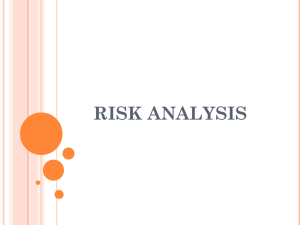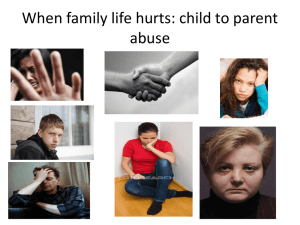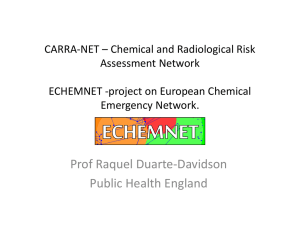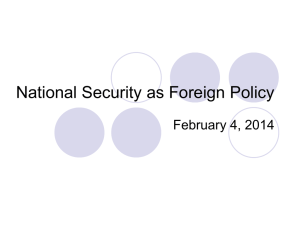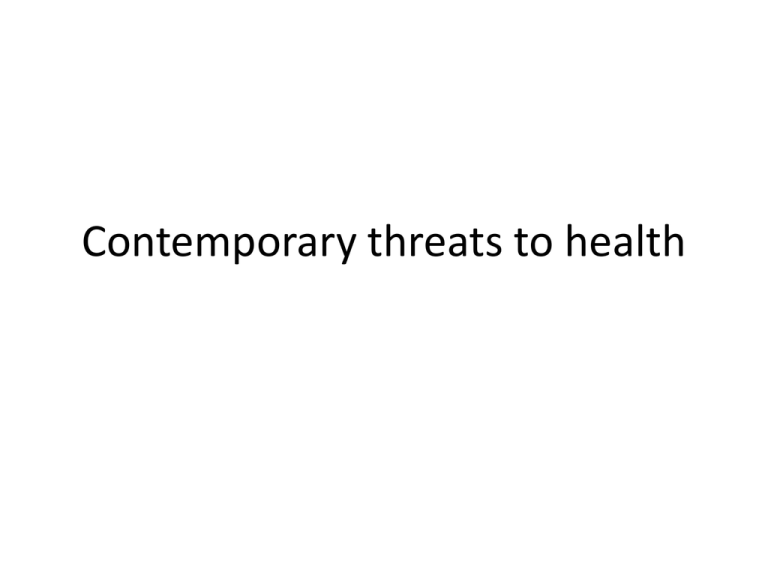
Contemporary threats to health
Session aims
• To develop your understanding of how health
threats can be conceptualised
• To analyse how changing patterns of health
relate to key societal events
• To identify the main public health issues
within contemporary society
Conceptualising and determining
threats to health
• Defining what we may see as a threat to health will be
intrinsically linked to how we define health.
• If we define the influences on our health as biological in
nature, leading to ill-health and malfunctioning of the
healthy physiological state of the body, threats will be
conceived as factors influencing our biological states.
• If we subscribe to the social model of health and
acknowledge the importance of socio-economic factors in
determining well-being and disease then we will view
threats more broadly and shaped by the social world in
which we live
Causal pathways
• Examining the causal pathways for health and illness
can aid our understanding of the diversity of threats to
health.
• Bhopal (2008) provides a useful model for analysing
the complexity of causal pathways called a web of
causation which visualises the interconnectedness of
factors that influences health and illness.
• Bhopal’s (2008) diagram represents a complex group of
health determinants such as the environment,
behaviour and the workplace. It also shows the interrelatedness of these factors in terms of how they
contribute to the occurrence and spread of disease.
Contemporary discourse
• The dominant contemporary discourse for health is one of
threats and disease.
• Gidden's (2009) argues that the societal focus upon health
risks leaves both governments and individuals debating the
outcomes of such risks because there are no definitive
answers.
• Generating positive health is often a less important priority
than preventing and reducing mortality and morbidity.
• Most ‘health’ targets which underpin practice are framed
around reducing illness.
• There are some examples of targets that consider the wider
determinants of health e.g. the Millennium Development
Goals
Magnitude and severity
• Other factors that can influence what issues are seen as threats to
health are the number of people affected and the seriousness of
the threat.
• Large and visible dangers tend to receive more attention and are
therefore more likely to be categorised as threats to health.
• Pandemics can be classified as stronger threats because of their
scope being across continents and the world.
• Notions of mortality (death), morbidity (burden of diseases), impact
on quality of life and chronic and acute disease can also be brought
to bear on how threats are conceptualised
• However, some issues that are perceived by society as stigmatised
or shameful can go under-reported, under-investigated and
unrecognised, for example disability.
Media construction and moral panics
• The way that health issues are reported within the mass media influences
understandings of the nature of these threats.
• Media generated scares often emphasise both physical and emotional
threats that are posed by everyday occurrences such as sunbathing, using
a mobile phone and vaccinations like Measles, Mumps and Rubella (the
combination of three vaccines into a single injection known as MMR)
despite the lack of science behind many of the claims that are made
(Wainwright, 2009).
• The media plays a role in the social amplification of risk, where risks
categorised as minor by scientific experts actually elicit strong public
concerns and even reactions, resulting in large scale impacts.
• Health scares reported in the media arguably give rise to a heightened
sense of public panic, creating more physical and mental vulnerability
(Buckingham, 2009).
• People often have higher levels of fear than are necessary (Buckingham
2009).
Changing threats across the 20th and
21st Century
• The types of diseases that affect populations change as
countries develop, so risks shift from infectious diseases
such as cholera in poorer countries to non-communicable
and lifestyle associated health problems such as cancers
and heart disease in richer countries.
• Wainwright (2009) labels this as an ‘epidemiological
transition’
• The WHO (2009) labels this as a ‘risk transition’ caused by
improvements in medical care, the ageing of the population
and successful public health interventions such as
vaccinations and sanitation.
• The impact of risks to health varies at different levels of
socio-economic development.
Contemporary threats to health:
Climate Change
(Summerhayes 2010)
Main impact of climate change
Some effects on health
• Extreme weather events
Increasing burden from malnutrition,
diarrhoeal, cardio-respiratory, and
infectious diseases
•Changes in levels of water
•Changes in food production
•Damaged eco-systems
Increased morbidity and mortality from
heat waves, floods, and droughts
Changed distribution of some disease
vectors e.g. mosquitoes transmitting
malaria
Risks from populations on the move
resulting in homelessness and
overcrowded conditions
Substantial burden on health services
Contemporary threats to health:
Degraded environments
• Our health is linked to the environment and the destruction of
the natural environment is therefore a threat to our health.
• In destroying our environment, we threaten our basic needs
such as food, shelter and clean air and water (Stone 2009).
• Degraded environments are associated with health problems,
and high levels of mortality.
• WHO evidence suggests that each year 800,000 people die
from causes related to air pollution, 3.5 million from
malnutrition and 1.8 million from lack of clean water (WHO,
2005b; 2008).
• All of these physical health problems certainly may impact
upon mental health too.
Contemporary threats to health:
population growth
Problems caused by population growth
Benefits of population growth
Population growth is generally argued to
be problematic for health because of
increased demands for scarce resources
including food, shelter, fuel, water and all
types of service provision (for example
education and health care).
Having a healthy population of working
age can serve to enhance economic
development which in turn promotes
better health (Bloom and Canning, 2001).
These factors will not only impact on
physical health but will also threaten
social and mental health as a
consequence of overcrowded living
conditions.
Contemporary threats to health:
Ageing population
• The WHO (2007a) predicts that the world's elderly
population (by which they mean people aged 60
years and over) will reach 2 billion by 2050.
• Ageing populations can result in
– changing patterns of illness and disease with
increased conditions associated with fragility,
chronic diseases and disorders such as dementia
– An increase in poverty and therefore associated ill
health for older age groups in society
• Preparing health providers and societies to meet the
needs of elderly people is essential
Contemporary threats to health:
safety, security and fear
Issue
Potential effects
Conflict and War
Deaths and injuries on the battlefield
Displacement of populations
Breakdown of health and social services
Heightened risk of disease transmission
Psychosocial impact of living with conflict
Domestic Violence
Physical injuries and death
Living in pain
Depression and post-traumatic stress
Poor esteem
Death and injury
Crime
Terrorism
Emotional impact long term stress
Direct death and injury
Rape as an instrument of war
Direct effect of psychological impact of
trauma and fear
Contemporary threats to health:
poverty
• Poverty and inequality limit the achievement
of full health.
• As a result of poverty individuals experience
under-nutrition, unsafe sex and poor
sanitation (WHO 2009) therefore increasing
their health risks significantly.
• Material deprivation plays a huge role in the
causation of disease
Contemporary threats to health:
inequality
• Gender health inequalities, e.g. risk behaviours such as
drinking alcohol are more prevalent among men
• Social Class inequalities, e.g. people in high social classes
having better health compared to lower social classes
• Geographical inequalities, e.g. Health is generally poorer in
the North of England compared to the South of England
• Ethnic inequalities, e.g. suicide rates in young Asian women
are more than double those for young white women in the
UK
• Age inequalities, e.g. many risk factors for poor health, such
as obesity, hypertension, disability and poverty increase
with age
(Raleigh and Polato 2004)
Contemporary threats to health:
mental health
• Mental health issues are often neglected in a world that tends
to prioritise physical health.
• Achieving good mental health is fundamentally important in
daily functioning, quality of life and integral to the health of
individuals and communities (Brundtland, 2001)
• The WHO (2001) suggests that approximately 450 million
people worldwide are suffering from some form of mental
disorder.
• One in four people will be mentally ill at some point in their
life, representing 13% of the global burden or morbidity
(WHO, 2001).
• A major issue for mental health sufferers is the serious stigma
and discrimination associated with poor psychological and
psychiatric status. Indeed, stigma is a major barrier to both
mental health treatment and recovery (Pinto-Foltz & Logsdon
2009).
Contemporary threats to health:
infectious diseases
• There are many infectious diseases that threaten
the health of humans such as rotavirus, Ebola,
HIV and the more recently discovered SARs and
H5N1, bird flu (Kaufmann 2009).
• These epidemics are transnational and hard to
control, so instil fear in many people.
• Experience varies according to where you live about four million people die annually from
respiratory infections, mostly in lower income
countries.
Contemporary threats to health: reemergence of infectious diseases
• On some occasions, a number of infectious diseases have been
declared to be ‘defeated’ and eradicated and then later reappear to
once again pose a threat to the health of humans.
• Tuberculosis is one such example within contemporary society
(Kaufmann, 2009).
• This is partly because of TB’s close relationship with those infected
with the HIV virus, so people often develop TB as a result of their
weakened immune systems
• The situation has been made worse by the bacterium that causes
TB becoming increasingly resistant to drugs and treatment.
• The principle reasons for the re-emergence of the disease are
overcrowded housing, increasing homelessness, rising immigration
rates, poor urban living conditions and rising levels of HIV infection
(Kaufmann 2009).
Contemporary threats to health: lifestyle diseases
• The types of food we choose to consume, levels of
inactivity, our sexual behaviour, attitudes to alcohol
and recreational drug use as well as attitudes to risk
are all having a huge impact on our health.
• The prevalence of obesity in England is the highest in
the European Union. So in 2005, 24.3% of UK females
were obese and 22.1% of men were.
• Changing life-styles are affecting health.
• The idea of life-style choices as a threat to our health
has been associated with victim blaming.
Summary
• Identifying substantive health threats is constructed by
definitions of health, considerations of determinants of
health, magnitude and seriousness and media and
moral panics about health threats.
• Epidemiological transition has changed global patterns
from infectious diseases at the start of the 20th Century
to chronic diseases in the 21st Century and this pattern
is predicted to continue.
• Health threats in the 21st century will require global
action around the major determinants of health such
as poverty, inequity, climate change and population
growth.


